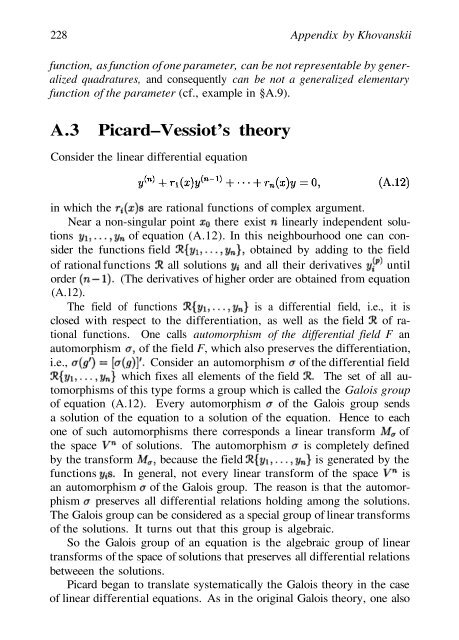Abel's theorem in problems and solutions - School of Mathematics
Abel's theorem in problems and solutions - School of Mathematics
Abel's theorem in problems and solutions - School of Mathematics
You also want an ePaper? Increase the reach of your titles
YUMPU automatically turns print PDFs into web optimized ePapers that Google loves.
228 Appendix by Khovanskii<br />
function, as function <strong>of</strong> one parameter, can be not representable by generalized<br />
quadratures, <strong>and</strong> consequently can be not a generalized elementary<br />
function <strong>of</strong> the parameter (cf., example <strong>in</strong> §A.9).<br />
A.3 Picard–Vessiot’s theory<br />
Consider the l<strong>in</strong>ear differential equation<br />
<strong>in</strong> which the are rational functions <strong>of</strong> complex argument.<br />
Near a non-s<strong>in</strong>gular po<strong>in</strong>t there exist l<strong>in</strong>early <strong>in</strong>dependent <strong>solutions</strong><br />
<strong>of</strong> equation (A.12). In this neighbourhood one can consider<br />
the functions field obta<strong>in</strong>ed by add<strong>in</strong>g to the field<br />
<strong>of</strong> rational functions all <strong>solutions</strong> <strong>and</strong> all their derivatives until<br />
order (The derivatives <strong>of</strong> higher order are obta<strong>in</strong>ed from equation<br />
(A.12).<br />
The field <strong>of</strong> functions is a differential field, i.e., it is<br />
closed with respect to the differentiation, as well as the field <strong>of</strong> rational<br />
functions. One calls automorphism <strong>of</strong> the differential field F an<br />
automorphism <strong>of</strong> the field F, which also preserves the differentiation,<br />
i.e., Consider an automorphism <strong>of</strong> the differential field<br />
which fixes all elements <strong>of</strong> the field The set <strong>of</strong> all automorphisms<br />
<strong>of</strong> this type forms a group which is called the Galois group<br />
<strong>of</strong> equation (A.12). Every automorphism <strong>of</strong> the Galois group sends<br />
a solution <strong>of</strong> the equation to a solution <strong>of</strong> the equation. Hence to each<br />
one <strong>of</strong> such automorphisms there corresponds a l<strong>in</strong>ear transform <strong>of</strong><br />
the space <strong>of</strong> <strong>solutions</strong>. The automorphism is completely def<strong>in</strong>ed<br />
by the transform because the field is generated by the<br />
functions In general, not every l<strong>in</strong>ear transform <strong>of</strong> the space is<br />
an automorphism <strong>of</strong> the Galois group. The reason is that the automorphism<br />
preserves all differential relations hold<strong>in</strong>g among the <strong>solutions</strong>.<br />
The Galois group can be considered as a special group <strong>of</strong> l<strong>in</strong>ear transforms<br />
<strong>of</strong> the <strong>solutions</strong>. It turns out that this group is algebraic.<br />
So the Galois group <strong>of</strong> an equation is the algebraic group <strong>of</strong> l<strong>in</strong>ear<br />
transforms <strong>of</strong> the space <strong>of</strong> <strong>solutions</strong> that preserves all differential relations<br />
betweeen the <strong>solutions</strong>.<br />
Picard began to translate systematically the Galois theory <strong>in</strong> the case<br />
<strong>of</strong> l<strong>in</strong>ear differential equations. As <strong>in</strong> the orig<strong>in</strong>al Galois theory, one also

















